 |
|

|
|

|
 |
TABLE of CONTENTS
 |
Hwy 10 project in Elk River replaces 75-year-old bridge, improves pavement |
By JP Gillach, District 3 public affairs coordinator
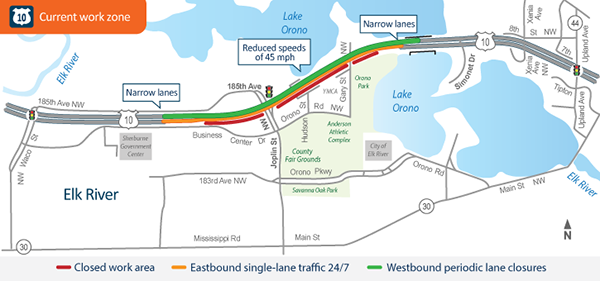
The Hwy 10 project in Elk River will replace the 75-year-old bridge over Lake Orono, among other improvements, by fall 2018. Graphic courtesy of District 3 |
Work began in early July on the Hwy 10 project in Elk River. When complete in fall 2018, the project will replace the 75-year-old bridge spanning Lake Orono with a new bridge; install a new signal system at the Hwy 10/Joplin Street intersection, improving traffic and pedestrian movements; replace approximately one mile of existing concrete roadway with new concrete pavement; construct a new trail along the south side of the highway; install new drainage infrastructure, and make other improvements to the project.
“Motorists, residents and businesses can expect the normal slowing of traffic through the work zone as well as rush hour and weekend back-ups that are normally associated with this type of a highway reconstruction project,” said Tim Paul, construction project manager.
Due to the high traffic volumes, resident and business needs, as well as other contract requirements, the project was designed with eight construction stages. Four stages will take place during the 2017 season; the rest will be completed during the 2018 season.
The Lake Orono bridge will be constructed in two primary stages, with the westbound portion being built first and the eastbound built second. In the end, the bridge will actually be two separate structures with a 3-inch gap between the center barriers.
“This stretch of roadway, including the Lake Orono bridge, was in bad need of improvement and with the use of multiple staging and tight timelines we should be able to accomplish our goals while at the same time maintaining traffic through the project,” said Paul.
For more project information, to view and print project maps, or sign up to have project email updates sent directly to your inbox, visit the Hwy 10 Lake Orono Bridge website. |
 |
|

|
 |
TABLE of CONTENTS
 |
Measuring movement with cutting edge video technology |
|
By Bob Filipczak, National Road Research Alliance How pavement, bridges and other pieces of infrastructure move as they are exposed to traffic can tell you a lot. It can help you decide things like weight restrictions, speed limits and more. Trouble is, measuring that movement can be tricky. That’s why MnDOT’s Materials and Road Research Lab is developing, and beginning to implement, video for digital image correlation—to find out what happens to pavement and structures when you drive a vehicle over it.
Digital image correlation has been around for years, explains Amy DiRienzo, staff engineer at RESPEC, a construction consulting firm that provided the software, training and equipment for this research project. She is working with Tom Burnham and Steve Olson from the Materials and Road Research Lab to get this up and running. The concept is pretty straightforward: You take a video camera, or more than one, and shoot video of a section of pavement or a bridge or any structure. Then you take some very advanced software and examine targeted pixels within the video and measure how each pixel moves.
Capturing the movement of structures on video has been around a long time; the first use was the Tacoma Narrows Bridge in the 1950s. What has changed is the processing power of computers and the software developed to do analysis. It’s gotten much, much better. That opens up the potential to measure a lot of things.
When DiRienzo’s company measures a railroad bridge, for example, it’s pretty easy to see and measure the movement. The movement is large and dramatic and it takes some time for everything to settle back into place after the train is gone. In such a case, RESPEC might shoot with a frame rate (frames per second) between 20 and 100. To give some perspective, regular video is about 30 frames per second. The more subtle the movement of the structure, the higher the frame rate required.
MnDOT however is measuring very subtle movement of pavement that snaps back into place very quickly. Consequently the department is using a frame rate of 1,000 frames per second with a two-megapixel camera. MnDOT also is using multiple cameras, which isn’t a common practice. The amount of data all of this generates is monumental, even by today’s computing standards.
The advantages of this system, especially over other typical measuring systems, are many:
- It’s easier and faster to set up.
- It measures the whole pavement surface, not just movement at the edges.
- It’s less intrusive in terms of closing roads and lanes.
- It’s safer for crews when working around traffic.
This will be the second year MnDOT takes its digital image correlation technology out of the lab and out into the field—measuring movement of both bridges and pavement. |
 |
|

|
 |
TABLE of CONTENTS
 |
Co-workers mourn loss of Land Managementís Lanette Zaiger |
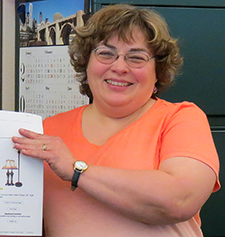
Lanette Zaiger, transportation specialist in the Land Management Office, died unexpectedly July 11. |
Lanette Zaiger, transportation specialist in the Land Management Office, died unexpectedly July 11. Zaiger, 55, was a MnDOT employee for more than 30 years. She worked in project coordination since 2005.
She met her husband, Jerry Kluthe, at MnDOT and they married Nov. 30, 2014. Jerry retired in 2015. She loved to work in her gardens alongside Jerry.
“Lanette was such a wonderful person,” said Julie Groetsch, Project Coordination Unit manager. “It is truly a great loss for Land Management and for everyone that she touched. She kept our little slice of the office green with plants that no one else was able to make bloom but her. Lanette will be dearly missed by all of us.”
One of the most important things to Zaiger was keeping family traditions alive. Her whole family loved fishing and for the last 30-plus years the family took an annual fishing trip to various locations throughout northern Minnesota.
“Lanette was a regular attendee of the Yoga at Noon class, where she really enjoyed the practice and the camaraderie,” said Joe Merkl, volunteer yoga instructor. “She will be greatly missed.”
Besides her husband Jerry, Zaiger is survived by many relatives and friends.
Family and friends will celebrate Zaiger’s life Friday, July 28. Visitation will be held from 1-2 p.m. at Mueller Memorial, 4738 Bald Eagle Ave., White Bear Lake. A memorial service will follow at 2 p.m. |
 |
|

|
 |
TABLE of CONTENTS
 |
On the job: Helping people find solutions is Jim Utecht's favorite part of permitting process |
By Judy Jacobs
Do you or a co-worker have an interesting job to share with readers? Send us your ideas, and we’ll contact you for more information.
Recent employee profiles:
|
 |
|

|
 |
TABLE of CONTENTS
 |
Interstate 35E MnPASS, Red Wing Hwy 61 projects receive recognition in regional competition |
|
Two MnDOT projects were among nine winners July 26 in the mid-America regional America’s Transportation Awards competition.
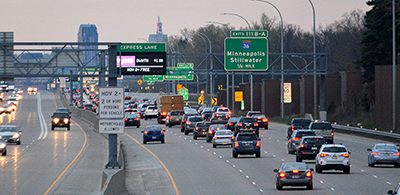
Cars use the Interstate 35E MnPASS lanes heading south towards downtown St. Paul. The project was recognized for the Best Use of Technology and Innovation at the Mid-America Association of State Transportation Officials Annual Meeting July 26 in Cleveland. MnDOT file photo |
The Interstate 35E MnPASS Project received recognition in the Best Use of Technology and Innovation category. The $120 million I-35E MnPASS Express Lanes marked a first-of-a-kind lane approach to having High Occupancy Toll lanes through an interchange commons area to keep traffic moving and increase safety for all motorists. There were also several technological innovations associated with the I-35E MnPASS Lanes, most notably the use of the nation’s first fully digital price signs. The full matrix 18-foot price signs allow greater flexibility in posting messages and allow MnDOT to provide motorists the information they need, when they need it.
The Highway 61/Main Street Project was recognized in the Quality of Life/Community Development category for projects costing under $25 million. The $9.7 million project illustrates how a collaborative partnership between MnDOT and the city of Red Wing met the needs to improve a road while also giving pedestrians easier access and additional safety protection across Hwy 61. MnDOT was able to split the project in two shorter construction seasons to not heavily impact the fall tourist season.
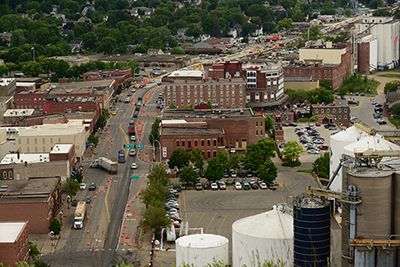
The Hwy 61 Main Street project in Red Wing was recognized in the Quality of Life/Community Development category for the collaborative relationship between MnDOT and the city of Red Wing. The project is shown under construction here in the upper center of the photo. Mn/DOT file photo |
The competition attracted 22 project nominations from nine mid-America states. Five of those states received awards for nine projects at the Mid America Association of State Transportation Officials Annual Meeting in Cleveland.
Sponsored by AASHTO, AAA, and the U.S. Chamber of Commerce, the competition recognizes transportation projects in three categories: Quality of Life/Community Development, Best Use of Technology and Innovation and new this year, Operations Excellence. Winners are chosen by an independent panel of judges from within the transportation industry.
The final regional winners will be announced in August. The three highest-scoring projects from each region will advance to the “Top 12.” Those 12 projects will compete for the Grand Prize, determined by an independent panel of expert judges, and the People’s Choice Award, selected by the general public through online voting. The top two winning prizes also come with a $10,000 check, to be donated to a charity or scholarship of the state DOT’s choosing. Online voting begins Aug. 21. The winners of the top two awards will be announced at the AASHTO Annual Meeting in Phoenix in September.
Learn more about the nominees and the competition at www.AmericasTransportationAwards.org. |
 |
|

|
 |
TABLE of CONTENTS
 |
Seeds and Phoenix Day celebrates student recruitment program |
By Dana Hernandez

Angel Glass, Land Management, enjoys the presentation during the annual Seeds and Phoenix Day July 15. Photo by David Gonzalez |
The 24th celebration of the annual Seeds and Phoenix Day was held on Thursday, July 13. The day centered on celebrating the diverse, multi-generational organization of MnDOT and was filled with acknowledgements, awards and presentations.
The college student recruitment program, Seeds, began in 1993, and the high school student early recruitment program, Phoenix, began in 2004.
Seeds and Phoenix students, supervisors, mentors and senior leadership came from various MnDOT districts for the day.
“I enjoy seeing the interest you all have in different subjects and the departments here at MnDOT,” said Deputy Commissioner and Chief Engineer Sue Mulvihill after students introduced themselves.
The Seeds and Phoenix programs recruit young talent and allow them to see the possibilities for their majors and how they align with MnDOT careers.
“Seeds and Phoenix Day was fun and an amazing opportunity to meet other students and supervisors. The program is a really great opportunity for us students,” said Seeds student worker Ayan Hassan, Office of Chief Counsel. “There are opportunities to learn and grow. One of the benefits of being a part of this program is having a realistic preview, or insight, of the different types of career fields that students are interested in.”
Jessica Etukudo and Calahena Merrick, Recruitment Programs, and Commissioner Charlie Zelle presented certificates of achievements and awards to the students.
Acknowledgements
- 11 Seeds graduates
- 19 New seeds students
- 8 Phoenix students transitioning to Seeds, student workers and fulltime positions
- 33 New Phoenix students
- 8 Current Seeds students
Awards
Student of the Year
- Isaac Berg, District 2
- James Bolton, Bridge
- Kirubel Shitta, Bridge
- Boxuan Xia, Environmental Stewardship
Supervisor of the Year
- Jihshya Lin, Bridge
- Calahena Merrick, Human Resources
- Susan Walto, Financial Management
- Khamsai Yang, Metro Design
New in 2017 are three awards acknowledging those who have gone above and beyond in supporting the programs and program staff.
Office Advocate of the Year
- Office of Transportation System Management
District Champion of the year
- District 2, Bemidji, Crookston
Champion of the Year
- Libby Schultz, Communications
“Diversity initiatives such as the Seeds and Phoenix programs are important and have a positive impact on our state agencies. I would really like to thank the different offices and districts for their continued support because they are the ones who really make programs like these prosper,” said Zelle.

Jessica Etukudo, TyShana Byrd-Guilmant and Lorianna Yang test the use of a customized Snapchat Geofilter at the Seeds and Phoenix Day July 13. Photo by TyShana Byrd-Guilmant |
Program achievements
The 2016-17 Seeds program’s focus was retaining MnDOT’s talent internally. With that focus and through an Office of Human Resources – Recruitment Unit WIG, a MnROW pilot program called Retaining Our Workforce was implemented to place recent college graduates within the agency.
This year, the program maintained its 100 percent placement rate with 11 students gaining full-time employment both internally (seven) and externally (four).
The nine Phoenix interns from the 2016 group was the largest number to have stayed with MnDOT upon their high school graduation and completion of the program.
“We are pioneers of targeted recruitment and diversity efforts,” said Etukudo. “In the last two years, the Governor’s Office has implemented new initiatives across all state agencies to partner with Step-Up and Right Track to hire more students (with an emphasis on diversity) into state agencies.”
Highlights
MnDOT created its first custom Snapchat Geofilter for Seeds and Phoenix Day. Snapchat, the widely used social messaging app, allows individuals, companies and agencies to design their own overlay that appears in certain locations. The locations are typically close to the corresponding entity or event. Snapchat users located within the St. Paul Transportation Building and the location of the event had access to the specialized filter.
Two presentations were given at the annual event this year. Verona Mitchell, Office of Equity and Diversity, presented to students and their supervisors “Intergenerational Workforce and What Makes an Inclusive Workplace.” Gina Kundan, Office of Equity and Diversity, presented “Having the Conversation, Communication in the Workplace.”
“All in all, it was an amazing day,” said Etukudo. “Students got to see that their presence is important in our organization. Senior leadership saw what their support, either financially or through encouragement of the program, actually translates to. Supervisors received the acknowledgement of their hard work. I am very proud of the event and feel that it serves as motivation to continue to expand these programs.” |
 |
|

|
 |
TABLE of CONTENTS
 |
Building bridges and public trust |
By Sue Mulvihill, Deputy Commissioner and Chief Engineer
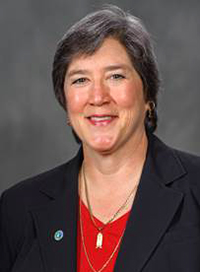
Sue Mulvihill, MnDOT deputy commissioner and chief engineer Photo by David Gonzalez |
2017 has been the summer of bridges.
Next week we will dedicate the new St. Croix River Crossing, a $646 million project involving two states, multiple communities and decades of debate. Its innovative extradosed design (which combines the elements of a concrete box girder bridge with a cable-stay bridge) makes the new structure only the second of its kind in the U.S. We worked hard to minimize the bridge’s negative effect on the environment while maximizing its usefulness as a transportation connector between Minnesota and Wisconsin. The result is an amazing bridge that’s built to last a century.
In September, we will celebrate the opening of the Hwy 53 bridge in Virginia, one of Minnesota’s tallest bridges. It, too, presented an engineering challenge, requiring us to move the highway, which was on mining land, to allow United Taconite access to the natural resources beneath it. The new highway bridge spans the Rouchleau Pit and will allow Hwy 53 to continue to serve as an important route connecting the cities of Virginia and Eveleth.
And earlier this summer we kicked off the construction for another bridge we share with Wisconsin, the Hwy 63 Mississippi River crossing in Red Wing. Work this season includes constructing the new river bridge piers and building a temporary Hwy 63 bridge over Hwy 61 to handle traffic while work on the permanent bridge is underway. The bridge is expected to open to traffic in 2020.
Remembering Aug. 1, 2007
For many of us, our thoughts also turn to a bridge known as #9340. This was the Interstate 35W Bridge in Minneapolis that collapsed into the Mississippi River Aug. 1, 2007. Thirteen people died and 145 were injured in the tragedy that garnered international attention. The National Transportation Safety Board cited the bridge’s “inadequate load capacity” due to a 40-year-old design error as the probable cause of the collapse.
It's a time in my career that I will never forget (I was the Program Delivery director for Metro District then). The collapse of the I-35W Bridge was traumatic for many of us at MnDOT. It still chokes me up when I think about it. In spite of the trauma, our whole agency rallied—people showed up to work without being asked, traffic restoration projects happened in a matter of days and weeks, and we were working on the details for a replacement bridge very soon after the collapse.
We pulled together to support each other and our customers. Thank you for that.
We can’t undo the collapse, but we as an agency, along with other state transportation organizations and the Federal Highway Administration, have done much during the past decade to ensure that such a tragedy never again occurs. Some of the changes include:
Bridge improvement program. The Legislature in 2008 provided special funding, known as the Chapter 152 program, to improve Minnesota’s state bridge system over 10 years. MnDOT identified 172 bridges that met the criteria established in statute. To date:
- 119 bridges (100 new and 19 rehab) are substantially complete
- 18 bridges are scheduled to be under contract for repair or replacement in 2017-2018
- 32 bridges judged to need only routine maintenance until beyond 2018
- 3 bridges are either privately owned or do not carry state trunk highway traffic
Bridge design, maintenance and inspection changes. We have made a number of changes to help improve our practices in these areas, including having:
- Established a peer review of consultant designs for major bridges, which have included the new I-35W/St. Anthony Falls Bridge, and the bridges in Hastings, Dresbach, Lafayette, Winona, Virginia, the St. Croix Crossing, and the St. Paul High Bridge re-decking project.
- Reviewed gusset plate adequacy (one problem cited for the collapsed bridge) of existing truss bridges to ensure their ratings are representative of inspection information and plate sizes.
- Accelerated inspection of all MnDOT bridges following the bridge collapse. This was completed by December 2007.
- Created the Structure Information Management System database to store all bridge inspection information and reports.
- Achieved fully compliant, substantially compliant or conditionally compliant status with all the metrics for the FHWA data-driven, risk-based system created in 2011 that established 23 metrics for annual review and compliance.
- Developed an extensive QC/QA plan for the decentralized bridge inspection program.
- Increased inspection access tools for inspectors, including six bridge snoopers, rope access training and equipment, and use of drones for inspection.
- Added independent structural engineer review for fracture critical bridge inspection reports.
- Increased district bridge maintenance staff and added two positions in the Bridge Office to provide expertise, guidance and training to district staff.
- Developed a Bridge Maintenance Academy training program.
- Established that the Bridge Office will perform all fracture critical and in-depth inspections because of inspector training requirements and to ensure the consistency of inspections, quality process improvement, and structural evaluation of components.
- Added language to construction specifications to limit the contractor’s storage of materials on a bridge (another contributing factor in the collapse).
- Developed the Bridge Replacement and Improvement Management system that uses inspection information, inventory data and expert reviews to identify and prioritize bridge projects.
There is a tradition among some university engineering programs to invite graduates to participate in the Order of the Engineer ceremony. Graduates recite an oath to uphold the standards and integrity of the engineering profession and receive a stainless steel ring to remind them of their responsibilities.
Like the engineer’s ring, the events of Aug. 1, 2007, and the people affected by that day, are a reminder to us of the tremendous responsibility we share every day in keeping our bridges, roads and all of our infrastructure safe for the public we serve. Every one of us has an important job to do. We will not forget.
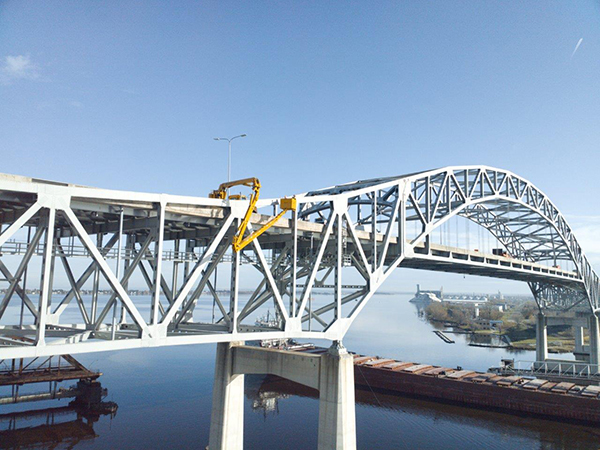
The Blatnik Bridge in Duluth is one of the 172 bridges in the Chapter 152 program. It's shown here in 2016 undergoing a bridge inspection. Photo courtesy of the Bridge Office |
|
 |
|

|
 |
TABLE of CONTENTS
 |
From the archives: MnDOT employees rise to challenges in aftermath of bridge collapse |
The Aug. 1, 2007 collapse of the Interstate 35W Bridge in Minneapolis grabbed headlines all over the world, and remained a fixture in the Twin Cities newspapers for months after the incident. MnDOT Newsline also was there capturing the role MnDOT employees played in responding to the tragedy and documenting the efforts for replacing the structure that once daily carried 140,000 vehicles across the Mississippi River. Below are some of those stories. Note: These links go to MnDOT's internal website.
Bridge collapse
New I-35W Bridge
Other bridges
Related stories
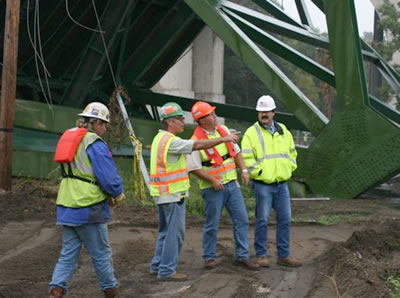
August 2007: Doug Thies, a Metro District safety administrator (second from right), reviews safety issues with representatives from OSHA and the contractor doing demolition work on the I-35W bridge. Photo by Julie Bottolfson |
|
 |
|
| |
|



